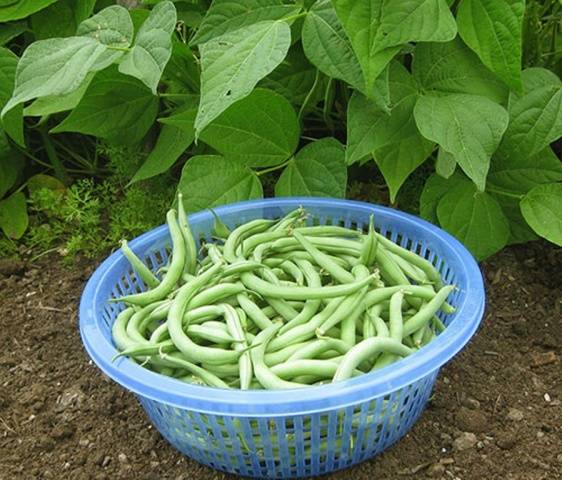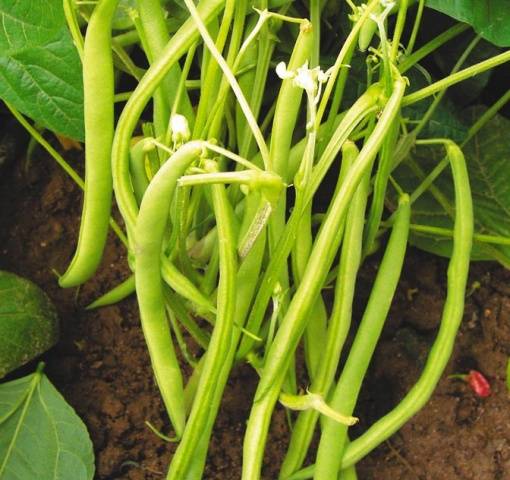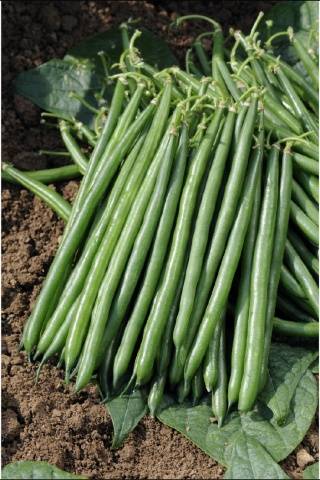Asparagus bean varieties They differ from the others in their delicate pulp, juicy pod leaves without hard fibers and parchment partitions. Beans need such hard flaps to protect the beans from mechanical damage and pest attacks. Specially selected asparagus varieties, on the contrary, have very tender pods, for this quality they are valued by gastronomic gourmets around the world.
The names and photos of the best asparagus bean varieties can be found in this article.
The best varieties of green beans
Like all other beans, asparagus varieties are divided into:
- bush (up to 60 cm);
- semi-curly (up to 150 cm);
- curly (up to 500 cm).
The method of growing these crops is approximately the same. The only difference is that tall asparagus must be tied to supports. But from one such bush, which takes up minimal space in the garden, you can get a good harvest.
Green beans can be of any selection: domestic, Italian, American, French or Dutch. Today, more and more often in Russian gardens you can find an exotic subspecies of asparagus beans - long-podded Vigna, whose homeland is considered to be Asia and India.
"Bona"
Beans of domestic selection, which are considered early ripening - asparagus ripening occurs on the 55-65th day after planting the seeds in open ground. The bushes of this variety are low-growing, compact - height is approximately 40 cm.
Mature pods reach a length of 15 cm, have an elongated round shape, and a slightly curved tip. The pod itself is fiber-free, tender and juicy. Inside it are five white beans.
This asparagus bean can be grown in any region of Russia, both in Siberia and in the Moscow region, asparagus takes root well and produces high yields. The bushes are resistant to diseases, and both pods and beans can be eaten.
"Blue Lake"
A super early variety of bean belonging to the climbing species. The bushes of this plant grow more than one and a half meters. Such asparagus must be tied to supports, so you will have to take care of their availability in advance.
Beans ripen on the 50th day after planting the beans in the ground. The pods grow long, about 16 cm, are bright green, even and smooth.
There are absolutely no hard partitions or fibers inside the pod, so Blue Lake asparagus is considered a dietary product, ideal for preparing low-calorie and healthy dishes.
Inside the pods there are small white beans that can also be eaten.
In order for the variety to bear fruit well, the bushes need to be regularly watered and fed. Beans love light, so they need to be planted in sunny areas.
"Sweet Courage"
A bush variety of asparagus beans that has a short growing season - asparagus ripens already on the 41-50th day after the first shoots emerge from the ground. The plants are low, compact, about 40 cm in height.
You can recognize this variety of asparagus by its cylindrical pods, which have a smooth bend and are painted bright yellow. The length of the beans reaches 14-17 cm, has a delicate taste and a lot of vitamins in its composition.
"Neringa"
Another early bean is the Neringa variety of asparagus, which begins to bear fruit by the 55th day after the seeds are planted in the soil. The fruits of this variety are long pods of small diameter and round cross-section. Their maximum length reaches 16 cm. The seed capsule valves are fleshy, juicy, without hard fibers and a parchment taste.
Fruiting of beans is consistent - a bountiful harvest can be harvested all at once. Both the pods and the beans inside them are edible. The variety is suitable for cultivation in any region of the country, tolerates heat and low temperatures well, and rarely gets sick.
"Pencil Pod Black Wax"
A mid-season asparagus variety of Italian selection, fruit ripening occurs 60-65 days after planting. The bushes are small, about 40 cm, and are distinguished by their productivity, endurance, and compactness.
Ripe asparagus is light yellow in color. The pods are valued for their excellent taste and suitability for long-term storage and transportation. The pods remain dense and juicy for a long time, and their presentation does not deteriorate. Asparagus is about 15 cm long. Inside the pods are beans - glossy black beans.
"Mascotte"
The bushes of this asparagus variety are very compact. The beans ripen early - on the 50th day after planting, the first pods can already be collected.The French love this asparagus very much; they especially value the juiciness and crispness of the pods and the absence of fiber in their leaves.
Small bushes can be grown even on a balcony or window - this will allow you to enjoy tender asparagus all year round, even while in a city apartment, and not on a country plot.
The yield of the variety is very high, the pods are green, long (about 15 cm), and cylindrical in shape.
"Kentucky Blue Pole"
Americans love this variety of asparagus most of all because it is sweet and very juicy, and also produces high yields. The ripening period of this bean is extended to 65 days. Bushes are considered tall, asparagus is considered climbing. The height of climbing vines often exceeds 250 cm; these plants must be tied up or planted near fences, trees, and arches.
The length of the pods reaches 20 cm, they are green in color. The distinctive features of beans are durability, unpretentiousness and high yield. In general, the characteristics of the American hybrid are reminiscent of the Russian variety “Blue Lake”.
"Gold Mine"
Bush asparagus, which is distinguished by its very sweet pods. The crop is considered early ripening - the growing season of the variety is 55 days.
The bushes are powerful, upright, the asparagus grows in clusters, which significantly increases the yield of beans. From each bush of this variety you can harvest about 800 grams of asparagus.
The taste of the pods is unusual - they are very sweet, which is why children love these beans most of all.
"Fakir"
Mid-season beans belong to the group of asparagus called Vigna - the length of the pods reaches 50 cm. Moreover, the diameter of the pods does not exceed 1 cm, their flesh is tender and juicy.
Beans of the “Fakir” variety are a climbing plant; the length of the vine can reach 300 cm. Therefore, to grow this variety of green beans, supports are required.
The variety belongs to the development of domestic breeders, so asparagus feels great in Russian dachas and vegetable gardens, rarely gets sick, and produces high and stable yields.
"Spaghetti"
One bush of climbing bean of the Vigna subspecies produces about five kilograms of harvest. With good care of the plants, the pods can reach 55 cm, their diameter is small - only 1 cm.
A distinctive feature of asparagus is the tender and juicy flesh of the pods, the absence of hard partitions and peel. This asparagus also does not have the characteristic bean taste.
The plant is an early ripening plant - the beans ripen on the 60th day after planting the seeds.
"Fortex"
Asparagus variety from French breeders. It is distinguished by long pods, delicate pulp, and a pronounced fresh taste. These beans do not have hard wings or partitions; they are easy and quick to prepare and contain a lot of useful substances.
The length of the pods reaches 20-30 cm, but not only asparagus is valued in this variety. The French also eat chocolate-colored beans, which are found inside the pods. The ripening period of beans is late - the growing season is 75-80 days. Therefore, it is better to grow French beans in a greenhouse or in gardens in the southern part of the country.
"Red Podded Asparagus"
The powerful climbing bushes of this variety are decorated with many long pods of a purple hue - such beans will definitely not go unnoticed; they will become the attraction of a summer cottage.
The length of the pod can reach 80 cm, but experienced gardeners recommend eating asparagus, which is about 0.5 meters long - in this form the beans are more tender and juicy.
"Asparagus Yardlong"
Classic asparagus of the Vigna subspecies, all varieties of which are distinguished by long pods. Climbing bushes can grow up to four meters in height and must be tied to strong supports.
The pods themselves are also gigantic - their maximum length is 80 cm. The crop is considered unpretentious, protected from diseases, and very productive.
The growing season is 80 days, so Vigna is a late-ripening variety of asparagus. It is better to grow it in greenhouses, because the climate of most of Russia is characterized by short and cool summers - in these conditions the beans simply will not have time to ripen.
Not only can you eat the pods, the beans inside are also very tasty, with a slight nutty flavor. Beans make surprisingly tasty dishes, aromatic and very healthy.
Rules for growing green beans
All types of legumes are quite unpretentious and do not require special care.
To grow good asparagus, you need to follow a number of simple rules:
- Sow seeds in well-warmed soil (above 12 degrees) or pre-grow seedlings.
- Place beds with beans on the sunny side of the site.
- The soil should be loose and nutritious. If the soil is very acidic, it is necessary to add ash or dolomite flour.
- The beds with planted beans are not watered until green shoots appear.
- They protect the bushes from strong sunshine; the heat can cause the beans to drop their flowers.
- When the plants have four leaves, stop watering until the beans begin to bloom.
- During the entire growing season, asparagus needs to be fed twice.
- You need to pick the pods in time before they become hard and rough.
Vibrant photos of asparagus simply insist that you try it. After all, this product is considered dietary - asparagus is very useful for both adults and children, it contains a whole complex of vitamins and microelements.


























